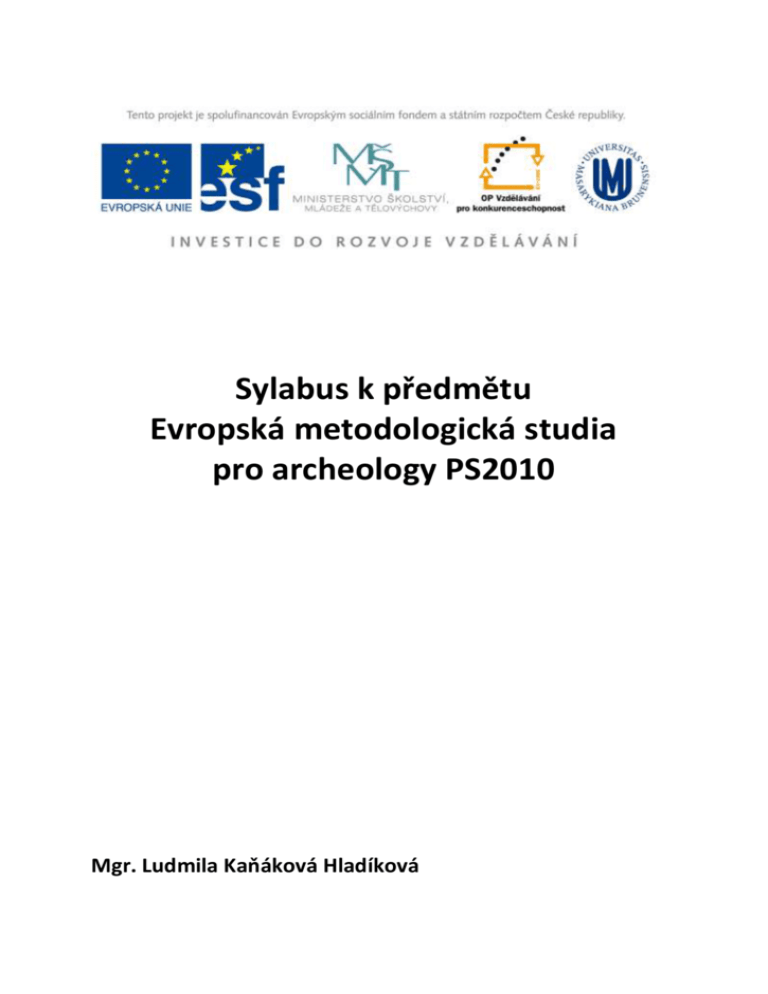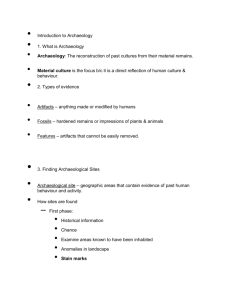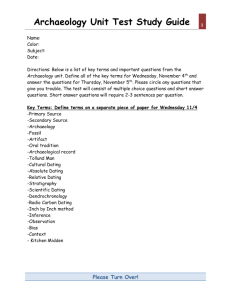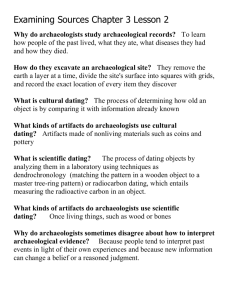Click here to get the file
advertisement

Sylabus k předmětu Evropská metodologická studia pro archeology PS2010 Mgr. Ludmila Kaňáková Hladíková Dr. Richard Macphail has had some 30 years post-doctoral experience in archaeological soil micromorphology, and is in the forefront of current research, for example, in caves, urban archaeology, experiments, buried soils and floors. His research interests include especially palaeoagriculture, urban archaeology, early human hunter-gatherers, caves and experimental archaeology. His main research theme is Integrated microstratigraphic analysis of soils and archaeological deposits employing soil micromorphology and microchemical (e.g., microprobe) techniques, combined with bulk chemical and magnetic susceptibility and microfossil (e.g., pollen) investigations – with teams. Other research lines are Experiments in geoarchaeology: Animal husbandry (pigs) at West Stow Anglo-Saxon Village, Suffolk, England. Also at West Stow craft building and sunken-feature building studies in association with Jess Tipper [Suffolk County Council] and in collaboration with Drs Charles French [Cambridge] and Karen Milek [Aberdeen]; grubenhäuser studies in association with Professor Joachim Henning [Frankfurt] and his students. Integrated microstratigraphic studies of: the effects of soil burial at the UK Experimental Earthworks of Overton Down (rendzinas) and Wareham (podzols); use of space in structures, arable and pasture soils and settlement morphology at Butser ‘Ancient Farm’ (Hampshire, UK); sustainable agriculture in the boreal zone and turf roof structures at Umeå ‘Ancient Farm’ (north Sweden). : Contribution of ‘Roman’ floor sweepings to the formation of ‘dark earth’ – material being collected from kitchen of Sparsholt Villa constructed at Butser ‘Ancient Farm’, UK; contributions also from roundhouse and industrial areas. Collaboration with other reconstructed Roman settlements such as Bliesbruck [La Moselle, France; with Dr Anne Gebhardt, AFAN] also under discussion. : Effects of marine inundation of soils at Wallasea Island, Essex, UK 2006-08, and high resolution monitoring of new mudflat sedimentation and weathering (integrated studies include chemistry, diatoms, foraminifera and ostracods, molluscs and pollen); opportunity to set up experimental land uses (middens, flint scatters etc) ahead of planned flooding of the whole of Wallasea Island in 2010 has the support of the Royal Society for the Protection of Birds (RSPB) the new land owners who have agreed to facilitate this within their planned construction of different intertidal and wetland habitat. : Combined micromorphology, microprobe and FTIR mineralogical studies of reference materials (e.g., ancient human waste), in collaboration with Professor Paul Goldberg and Dr Francesco Berna, Boston University). Institute of Archaeology University College London 31-34 Gordon Square London WC1H 0PY United Kingdom r.macphail@ucl.ac.uk http://www.ucl.ac.uk/archaeology/staff/profiles/macphail.htm přednáška 30. září 2010 1: Dating soil micromorphology and geoarchaeology I: Analysis of sites where natural environmental (taphonomic) processes predominate. In open air Palaeolithic sites, artefacts, artefact concentrations and rare hominin remains, occur within sediments and palaeosols where natural site formation processes predominate. These taphonomic processes need to be carefully understood in order that: a) the environment associated with the occupation is properly understood in relationship to both the contemporary environment and post-depositional processes, b) soil micromorphological information can be accurately integrated within the full geoarchaeological and palaeo-environmental dataset to develop consensus interpretations of past landscapes (collaboration with chemists, macro- and micro-fossils, etc), and c) dating estimations by various methods can be investigated for consistency against the geoarchaeological character and history of sites (collaboration with specialists in dating). Site examples will include Mid-Pleistocene Boxgrove, West Sussex and the cave of Westbury-subMendip, Somerset (UK) and Upper Pleistocene Han Tan River (Imjin River, Korea), as well as other English archaeological sites and experimental studies. 2. Dating soil micromorphology and geoarchaeology II: the development of anthropogenic deposits and their interpretation. Even where human cultures have hardly developed into complex societies, occupations can form thick anthropogenic deposits that characterise their lifestyle. Examples can be cited from the Italian coastal cave sites of Uzzo Cave, Sicily, Italy, where there is almost a unique boundary between Mesolithic and Neolithic occupations. Arene Candide Cave, Liguria, Italy (Neolithic) and Atzmaut Cave, The Negev, Israel (Early Bronze Age), are further examples where rapid cave sedimentation is due to occupation by pastoralists, but in two totally different environmental settings; one on the coast the other in a desert. Dating these sequences has been crucial to their understanding in the context of the local and regional archaeology. As would be expected, urban areas generate thick anthropogenic deposits that reflect different and changing uses of space. One of the challenges for the archaeological soil micromorphologist is to interpret these different uses of space, when urban sites become disused, abandoned or experience a change in use/population density. In addition, site sedimentation and post-depositional processes are investigated as a function of time. Examples will be given of such sites, including English Roman and early medieval urban sites, and Late Antique sites at Tours and Tarquimpol, France.b) soil micromorphological information can be accurately integrated within the full geoarchaeological and palaeo-environmental dataset to develop consensus interpretations of past landscapes (collaboration with chemists, specialists in dating, macro- and micro-fossils). Site examples will include Mid-Pleistocene Boxgrove, West Sussex (UK) and Upper Pleistocene Han Tan River (Imjin River, Korea), as well as other English archaeological sites and experimental studies. .................................................. Professor Christopher Hall MA DPhil DSc (Oxford) CEng FRSC FIM FRSE Professor of Materials, The University of Edinburgh 1999 -Director of Research, School of Engineering and Electronics 2002--2008 Honorary Visiting Professor, School of Mechanical, Aerospace and Civil Engineering, University of Manchester 1994-Visiting Scientific Advisor, Schlumberger Cambridge Research 1999--2005 Visiting Fellow, Princeton University 1998 Senior Member, Robinson College, Cambridge Brian Mercer Senior Award, Royal Society 2001 Visiting Scientist, DeltaMin Marie Curie Network 2009--2012 Research interests My main scientific interests are in the chemistry of materials and geomaterials used in oilfield and civil engineering, and the application of several advanced experimental methods. I have worked extensively on capillary liquid transport in porous construction materials (NMR imaging methods, measurement of transport properties and modelling of capillary flow). At present, my research activities are in experimental methods for studying reactive transport and chemomechanical processes in complex inorganic materials such as rocks and cement-based materials. Our recent work includes the development of synchrotron-based diffraction tomography, the application of scanning probe microscopy to mineral/water reactions; the hydrothermal chemistry of materials under deep borehole conditions; and analysis and chemistry in archaeology and building conservation. Centre for Materials Science & Engineering and School of Engineering & Electronics The University of Edinburgh Sanderson Building King's Buildings Edinburgh EH9 3JL UK +44 131 650 5679 direct +44 131 650 4860 office +44 07798 790048 mobile Christopher.Hall@ed.ac.uk přednáška 14. října 2010 Rehydroxylation of ceramics ................................................ Prof. Goran Skog Ass. professor Department of Earth and Ecosystem Sciences, Divison of Geology Lund University Sölvegatan 12 SE-223 62 Lund Sweden +46 46 222 3948 +46 46 222 7885 Goran.Skog@C14lab.lu.se http://www.geol.lu.se/c14/en/ přednáška 25. listopadu 2010 Developments in 14C AMS dating for archaeology. This lecture will focus on following topics: The production of cosmogenic nuclides and 14C; the incorporation of 14C in living organisms; methods of measuring 14C and the advantage of the AMS technique; developments of the AMS technique and the trend towards smaller machines; sources of error in radiocarbon dating; isotopic fractionation and the marine reservoir effect; archaeological materials used in radiocarbon dating and their reliability. ................................................. Dr.rer.nat. Dr.phil.habil. Daniel Richter is currently a researcher at the MPI-EVA, where he is installing and running a luminescence dating laboratory. The major subject of his studies was hunter gatherer archaeology at the University of Tübingen (Germany) and archaeology at University College London (Great Britain). For his Master thesis he excavated a Mesolithic open air site (RottenburgSiebenlinden II) in southern Germany. Initially trained as a Palaeolithic archaeologist, he switched to luminescence dating methods for his PhD to the Forschungsstelle Archäometrie der Heidelberger Akademie der Wissenschaften at the MPI for Nuclear Physics in Heidelberg. During that time he received the major part of his training in luminescence at the LSCE at the CEA-CNRS in Gif-sur-Yvette (France). Subsequent to the PhD he became a postdoctoral fellow at the Department of Geology at the McMaster University in Hamilton (Canada), where he received training in ESR-dating. Following his postdoctorate, he set up a luminescence dating laboratory at the Instituto Tecnológico e Nuclear in Sacavèm (Portugal). Fieldwork for numerous dating projects was performed in the Czech Republic, France, Germany, Israel, Morocco, Portugal, Spain and Syria. Max-Planck-Institute for Evolutionary Anthropology Department of Human Evolution Deutscher Platz 6 04103 Leipzig Germany tel: 0049 (0) 341 3550 354 drichter@eva.mpg.de přednáška 2. prosince 2010 "Dosimetric dating methods in archaeology: Fundamentals and applications" Dosimetric methods allow the dating of teeth, heated flint and sediments from archaeological and geological sites. In each case a different event is dated by the measurement of an accumulated radiation dose with ESR, TL and OSL, respectively. The fundamentals and the potential, but also the problems of the three methods will be discussed. Detailed information will be provided for their use by archaeologists, and procedures, e.g. sampling, will be explained together with selected application examples. ................................................ Ing. Dr. Michael Grabner is a currently researcher of BOKU Wien. His research is focused on dendrochronology, tree ring analysis, wood quality, wood biology and wood anatomy. He has obtained several scientific awards: Josef Umdasch Forschungpreis (2008), Theodor Körner Preis (2006), Preis der Stiftung „120 Jahre Universität für Bodenkultur (2003), Klaus Fischer Innovationspreis für Technik und Umwelt (2002). Dr. Grabner is expert member of Managment comittee member COST IE0601. His studies and articles are fully available on https://forschung.boku.ac.at/fis/suchen.person_praesentationen?sprache_in=en&menue_id_in=105 &id_in=5335. Universität für Bodenkultur Wien Peter Jordan Strasse 82 1190 Vienna michael.grabner@boku.ac.at Tel. ++43-1-47654--4268 Fax. ++43-1-47654-4295 www.boku.ac.at/holzforschung přednáška 16. prosince 2010 “Dendrochronology - Requirements, Problems, possible solutions“ I will try to do a little bit on the method itself but concentrate on requirements, problems and solutions. Including sampling, conservation, non destructive sampling (x-ray CT), lack of chronologies and ending with a lot of examples from Bronze Age up to medieval constructions.









